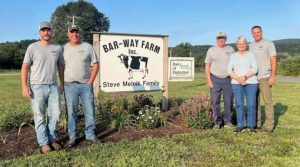
I am passionate about dairy — whether a glass of milk, cup of yogurt, or bowl of ice cream, I love it all. I’m also passionate about the people and families involved in getting those products to table, and working with them to ensure dairy is produced responsibly. In some circles lately, dairy’s been getting a bad rap. In reality, dairy contributes less than 2 percent to US GHG emissions, and it’s on a strong downward trajectory.
This isn’t an accident. What you may not realize is that dairy farmers — and all members of the dairy supply chain — have been quietly leading in the sustainability space for over a decade. I reached out to some friends in the industry to gather a range of perspectives about dairy’s sustainability journey — and more importantly, the lessons we have collectively learned — to share them with other industries and groups.
Dairy leadership in sustainability
Dairy farmers have always taken pride in providing a highly nutritious product while being responsible with resources. As part of this responsibility, dairy was the first agricultural commodity to perform a life cycle assessment — in 2008.
“Our farmers and industry understood that we needed to be able to chart our progress — both in our ability to move things forward — but also to make sure that we were pursuing practices and technologies that were financially feasible,” says Lisa Watson of the Dairy Innovation Center. “We were going to be able to go further faster if we pulled our whole chain together in those areas that were pre-competitive. … And that’s really the foundation upon which the Innovation Center for US Dairy was formed.”
Dairy has since pioneered a series of pre-competitive collaborations that encompass all elements of the value chain — from farmer coops and processors, to not-for-profit groups and retailers. Here are some key examples:
The Dairy Sustainability Alliance: Founded in 2008, the Alliance recognized that “no one company or sector can address sustainability alone.” It now comprises 160+ members at the corporate level who strive to further the dairy community’s social responsibility goals.
2018 — US Dairy Stewardship Commitment: This commitment makes it possible for U.S Dairy to publicly measure and track its progress. 34 Companies representing 75 percent of US milk production have adopted this action-oriented pledge.
2020 — Set industry-wide Environmental Stewardship Goals, including to achieve greenhouse gas neutrality by 2050
2020 Net-Zero Initiative: US Dairy founded this initiative to accelerate voluntary action on farm to reduce environmental impacts, by making sustainable practices and technologies more accessible and affordable to US dairy farms of all sizes and geographies.
“The farmers, cooperative members and processors came to alignment and agreement over a common goal — one that is time-bound, quantitative and public,” says Emily Johannes, Sustainable Sourcing Manager at Nestlé. “I think that’s a real demonstration of leadership.”
The industry is already taking this leadership approach to other areas. In 2020, Dairy Farmers of America co-founded the Farm Powered Strategic Alliance (FPSA), along with Vanguard Renewables, Starbucks and Unilever. It is a collaboration to accelerate long-term commitments to avoid or eliminate food waste first, and repurpose what can’t be eliminated into renewable energy. Membership now includes Cabot Creamery, Stonyfield Organic, Smithfield Foods and Kikkoman; another dairy company will be announced in 2022 that will make FPSA 50 percent dairy members, which is no surprise to me.
Lessons for others
The biggest lesson learned from dairy’s example is the importance of including all stakeholders along the supply chain, including competitors. As Watson emphasizes: “To build trust, you have to be willing to listen. You can’t be afraid to bring people together, to hear each other out and to better understand others’ priorities. When you focus a little more on listening versus talking, you’re likely to learn something that’s actually going to help you to move that ball forward.”
The second lesson is the importance of gathering data to measure and show what we’re doing now and to track our progress with integrity. Johannes agrees: “The key for dairy is that we now have an alliance that is backed up by action, by tools, and by verification systems. And I think that’s really what other industries can learn from. Quite frankly, I hope the advantage to other industries is to leverage the work that dairy has done and go even faster.”
All three of us agree that there’s no “silver bullet” solution.
Watson adds: “We focus on working with people to identify a range of options that are going to work best for different situations.”
“We want the best solutions we can get, but we also recognize that things may need to be adjusted and some things may fail,” Johannes says. “And we’re okay with the fact that this is a learning process.”
Final thoughts
The hope is that others can look to dairy’s example and shorten their own sustainability journeys. We can already see sustainability becoming inherent to the business strategy of many companies.
For Stonyfield Organic, sustainability has always been core to its business.
“’Healthy food, healthy people, healthy planet, healthy business.’ Other companies have used these words to describe their purpose, but few were founded on those values — and even fewer have stayed true to them for decades the way we have here at Stonyfield Organic,” says Gary Hirshberg, Stonyfield’s co-founder and Chief Organic Optimist. “We’re honored to work collaboratively across the dairy industry to drive further environmental change and protect our resources for generations to come.”
As food sustainability moves from how we tell stories to how we sell products — and ultimately, how we finance changes in practices — the US dairy industry is prepared to be a leader in delivering sustainable nutrition to consumers around the world.























